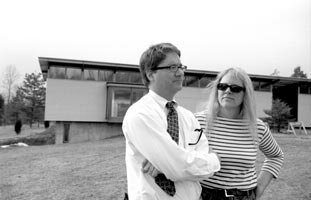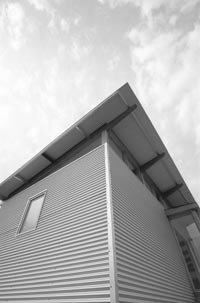ON ARCHITECTURE- Retrofit: Are SIPs the new way to build?
Like solar heating technology, Aerosmith, hip-hugging jeans, big belt buckles, long hair, and other artifacts from the '70s, insulated panel construction is making a big comeback.
"I'll never do another stick-built house again," declares Charlottesville architect Jim Rounseval, who designed his first insulated panel house in 2003 and has three more on the drawing board.
It's a sentiment shared by a growing number of architects these days. In fact, Rounseval says the insulated panel technology is even turning builders into converts.
"The construction industry is typically slow to change," says Rounseval, "but increasing labor costs and the ease with which these panel houses are put together, combined with their structural integrity, is making this kind of construction more attractive to builders."
Structural Insulated Panels (SIPs) are panels made with polyurethane foam sandwiched between two layers of plywood or fiber-cement. SIPs can also be filled with polystyrene (Styrofoam) or environmentally friendly wheat straw and other organic materials. These factory-manufactured panels are designed and cut to order, then delivered to the jobsite where they're assembled like Lego pieces, creating a strong, airtight, and energy efficient building shell in less than half the time it takes to frame a stub-frame house.
In a way, SIPs are a return to the old load-bearing wall idea because they contribute to the structural integrity of the house, but they also solve insulation and waterproofing issues. According to a PATH (Partnership for Advancement of Technology in Housing) report, "With the capacity to handle axial, bending, racking, and shear loads, properly designed and assembled SIPs not only replace conventional framing, but will withstand high wind and seismic forces."
According to Rounseval, the technology– which was originally developed during the energy crunch in the '70s– has been languishing for years as energy prices stayed relatively low. As with solar's comeback, insulated panel construction is being spurred by concerns about energy and housing costs, as well as the growing ethical motivation to build greener. But there's even more to it than that, say Rounseval and others.
In 2003, Charlottesville resident Mark Schuyler and his wife weren't looking to build a house that could withstand a hurricane, but they did want to be as responsible as they could about conserving energy. "Our original reasons were ethical," says Schuyler, "but we were concerned about the bottom line as well. It turned out to be much less expensive to build this way."
With Rounseval's help, Schuyler chose Thermacore SIPs from a company in Indiana. These SIPs use a polyurethane core that bonds the panels together as well as insulates. It's also extremely durable and fire-resistant. It's a type of construction that has been used for years to build pressurized jetliner fuselages.
As Rounseval points out, he was not impressed by the more common, and cheaper, practice of using SIPs with a Styrofoam core. "Styrofoam is easier to manufacture and easier to work with, so it's more common," he explains. "But it just doesn't hold up to heat and moisture. If you've ever seen a waterlogged Styrofoam cooler, you know what I'm talking about. It just disintegrates."
After Schuyler and Rounseval settled on a design, Rounseval sent in his drawings, and the panels were precut. At first, Schuyler was concerned about delivery costs, particularly because the company was so far away.
"As it turned out, it cost only about $500 to have the panels delivered," says Schuyler, "complete with a panel truck driver who unloaded the panels and hung them in place." According to Schuyler, his 1,700-square-foot house went up in two and a half days, a fraction of the time it would have taken a traditional stick built framing crew. In addition, Schuyler says his heating and cooling bills are less than $100 a month.
According to Rounseval, the builder was at first apprehensive about working with the panels. Like most traditional builders, he hadn't had any experience working with SIPs. However, after seeing how easy the process was and how sturdy the house was, the builder had the same reaction as Rounseval: "I might never do another stick built house again," he told the architect.
If all this sounds a little too good to be true, remember the old saying. There are some negatives to building such "air-tight" houses. As Schuyler points out, "The downside is you have to pre-plan." Indeed, putting up a SIPs panel house is such a one-shot deal that any glitches in the planning stages could spell disaster. Not only can the construction process be interrupted by poor design, but if ventilation issues aren't addressed properly, these energy-efficient air-tight houses can become big canister bombs or poison containers.
For instance, Schulyer made sure his building site was tested for radon, a poisonous gas that seeps from the earth in some places, before he started building. Also, Schuyler has a gas heating system, so without proper ventilation, it's not hard to imagine the outcome if there happened to be a gas leak.
Other critics of SIPs panel houses says that the emphasis on making them air-tight could lead to problems down the line if moisture is trapped inside. According to Boston architect Thomas A. Schwartz, an expert on building envelope performance, "Even small amounts of water penetration can have serious consequences. Improvement in air tightness can paradoxically create problems in moisture retention, because the lack of air flow slows drying."
But according to Rounseval, SIPs panels are a way to combat the effects of moisture. "Mold problems are a big concern these days," he says, "but with solid SIPs panels, there is no place for the mold to grow. Mold simply can't grow in a SIPs."
SIPs technology may be ripe for an even higher calling, says architect Katie Swenson, who directs the Charlottesville Community Design Center. "Take New Orleans, for example. What's the best way to rebuild down there? These new technologies certainly provide valuable options for much needed housing. Thermacore SIPs houses just make so much sense. They're easy to build, they're drip-dry, and they're hurricane resistant. The key is to get them into circulation in the building industry."
 According to Mark Schuyler, his 1,700-square-foot house (pictured above) went up in two and a half days, a fraction of the time it would have taken a traditional stick built framing crew.
According to Mark Schuyler, his 1,700-square-foot house (pictured above) went up in two and a half days, a fraction of the time it would have taken a traditional stick built framing crew. 
FILE PHOTO BY JEN FARIELLO#